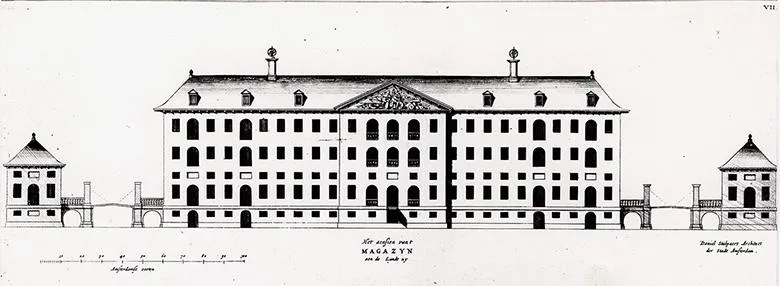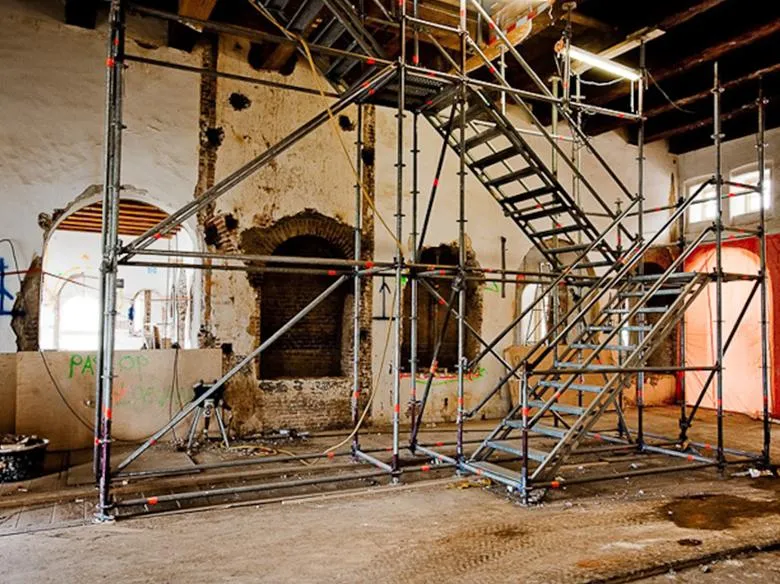The National Maritime Museum is housed in 's Lands Zeemagazijn (the Arsenal). This historic building dates from 1656 and was designed by Daniel Stalpaert as a storehouse for the Admiralty of Amsterdam.
The Arsenal was built in the seventeenth century, when Amsterdam was the largest port and market place in the world. Goods from all over the world could be bought right here. Today, over 350 years later, the Arsenal remains an imposing and impressive building with a great deal of character. It exudes history, making it the perfect location for The National Maritime Museum, which has been housed here since 1973.
History of 's Lands Zeemagazijn
Around 1590, Amsterdam experienced a period of explosive growth. In 1650, the town council had three new islands built for shipyards, warehouses and homes. The shipyard for the Admiralty of Amsterdam, with its adjacent storehouse the Arsenal was built on the island of Kattenburg.
The Arsenal opened in 1656. The storehouse held cannons, sails, flags and sailing equipment stored for the war fleet. The vaulted cellars under the inner courtyard were used to store rainwater - some 40,000 litres - to provide drinking water for the ships.
From its earliest days, the building has attracted tourists: the roof offered a beautiful view of the city. As time passed, not even the 2,300 foundation piles on which the Arsenal was built could prevent the building from subsiding. Buttresses (the angled 'feet' under the building) and extra ressaults (the extensions on the outside) were added to remove any risk of collapse.
In 1791, the inside of the building was gutted by fire, leaving only the stone shell of the outer walls. The charred brickwork was covered with a layer of plaster leaving the appearance of stately blocks of sandstone.
In 1795, Napoleon entered the country and found the Batavian Republic. The five Admiralties were abolished and replaced by a national navy. The Arsenal became and remained a storehouse for the navy until the early 1970s.
In 1972, the Arsenal began a new life as a 'storehouse' for the best pieces of The National Maritime Museum's collection. The museum became a national museum, which considerably expanded its options for financial support. The museum was officially opened by Princess Beatrix on 13 April 1973.

drawing of 's Lands Zeemagazijn (the Arsenal) by Daniel Stalpaert
The renovation (2007 - 2011)
In 2007 The National Maritime Museum closed its doors for a major renovation of 4 years. To become better fitted as a museum, the Arsenal needed larger halls, adjustments for the increasing number of visitors, and better climate control.
Liesbeth van der Pol (founder of Dok architects) took on the design of the renovated museum and its public space, reception rooms, restaurant and library. To preserve the atmosphere of a 17th-century storehouse, the architect deliberately restricted her design. The only added elements are of glass and metal - materials that emphasise the imposing character of the building.
- Renovation expenses: 58 million euros funded by the Dutch government)
- Museum refurbishment expenses (interior and exhibitions): 17.5 million euros (funded by The National Maritime Museum)

work in progress on one of the staircases
The glass roofing
Perhaps the high point, figuratively and literally, of the renovation was the glass roofing of the inner courtyard. Its self-supporting construction is made up of thousands of pieces of glass in a metal frame. With this dazzling glass ceiling, the Open Courtyard has been given a complete new function as central square and event location.
- self-sustaining construction of 34 x 34 metres
- designed by Laurent Ney (Ney + Partners) and built by Anmeco
- inspired by the compass lines on old nautical charts
- expenses: 3 million euros (part of the renovation budget)
- 160.000 kg steel and 40.000 kg glass
- 1200 pieces of glass
- 868 led nodes